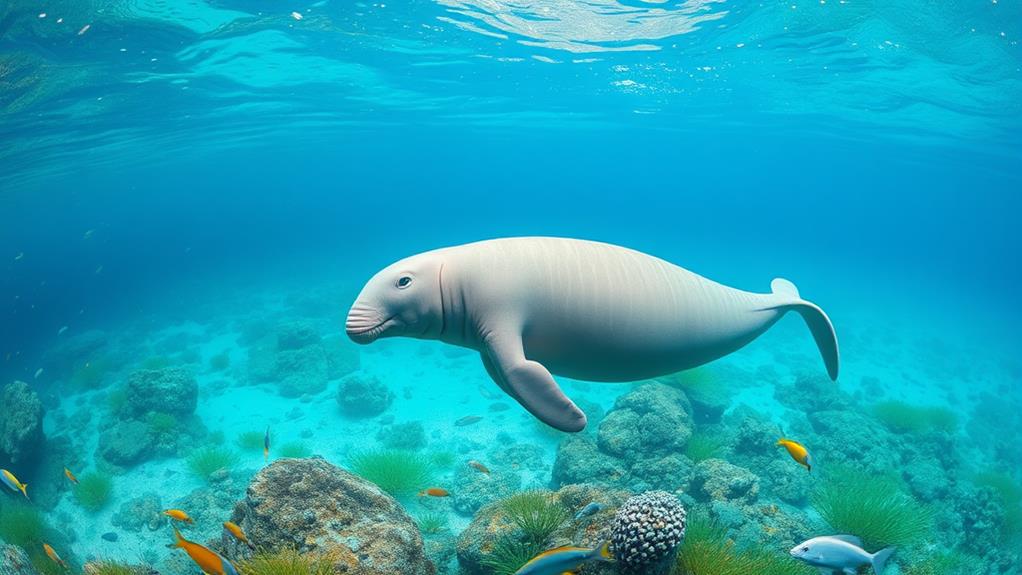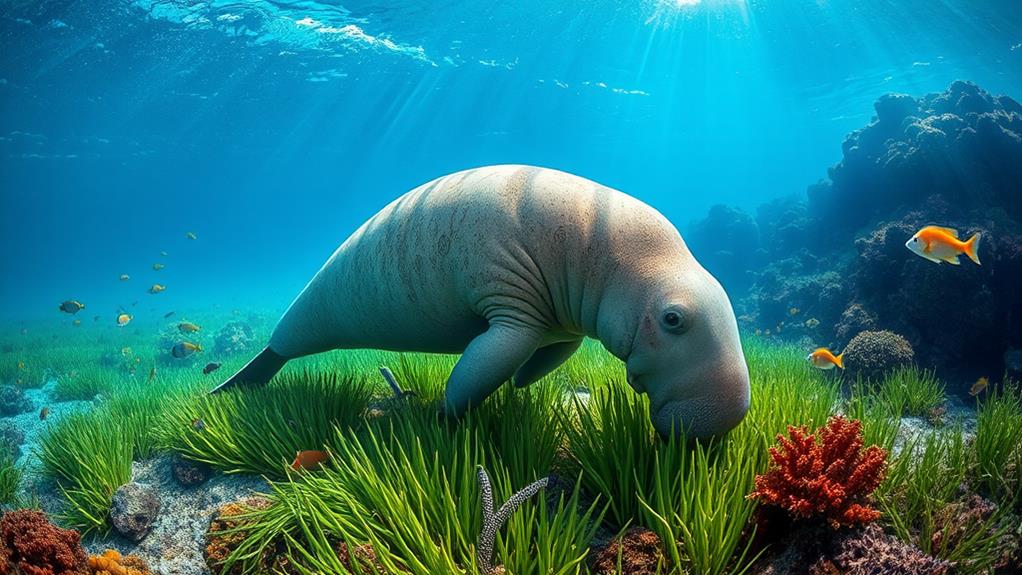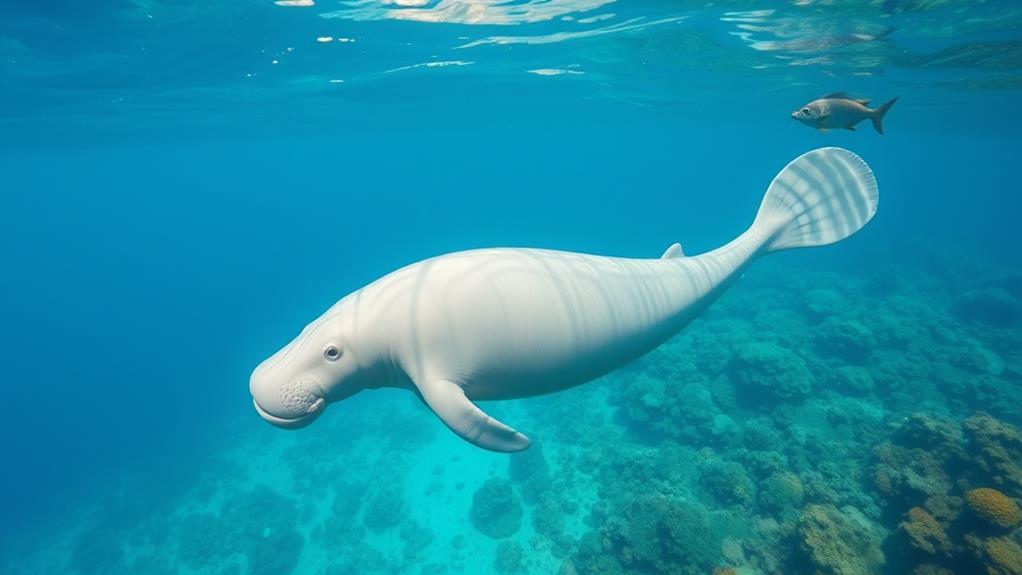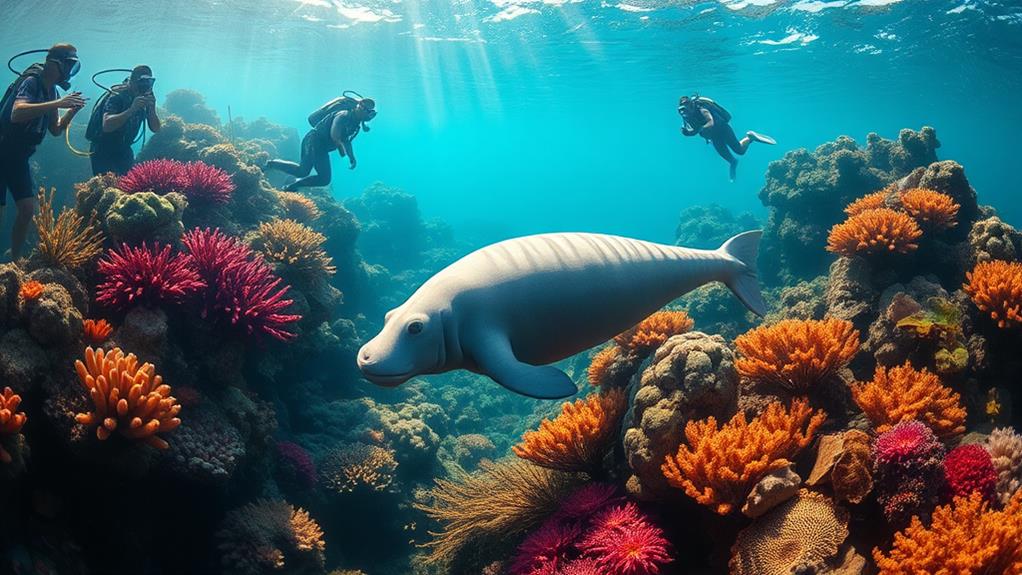Dugongs are crucial for maintaining healthy seagrass ecosystems. They feed exclusively on seagrass, which helps control the grass's growth and supports marine biodiversity. For example, dugongs prevent seagrass from overgrowing and shading out other marine species.
Habitat loss, climate change, and fishing entanglement threaten dugong populations. These threats are exacerbated by the dugong's slow reproductive rate, making recovery efforts challenging.
Dugongs can only reproduce every 3-5 years, making it difficult for populations to recover from threats.
Engaging local communities in sustainable practices is essential for dugong conservation. By working with local communities, conservation efforts can focus on reducing habitat loss, mitigating the effects of climate change, and preventing fishing entanglement.
For instance, educating fishermen about dugong-friendly fishing practices can help reduce bycatch and habitat damage.
Overview of Dugongs

Dugongs are vital components of coastal ecosystems. They inhabit warm coastal waters and feed exclusively on seagrass, making them essential herbivorous marine species.
Their grazing habits maintain healthy seagrass beds, which provide habitat for various marine life and contribute significantly to coastal nutrient cycling.
Dugongs are large marine mammals. They can grow up to 9 feet in length and weigh as much as 1,100 pounds, distinguished by their fluked tails.
Social animals, they thrive in small groups and can hold their breath for up to six minutes while diving.
Dugongs face significant threats. Habitat loss, fishing entanglement, and climate change pose major challenges to their survival.
Conservation efforts are necessary to protect their habitats and ensure their survival.
Understanding the ecological role of dugongs is crucial.
By protecting these gentle giants, we safeguard their future and enhance the health of the entire marine ecosystem they support.
Habitat and Distribution
Dugongs inhabit shallow coastal areas and peaceful estuaries, where they feed on seagrass beds. These marine mammals are primarily found in the warm tropical waters of the Indian Ocean, particularly around the Bazaruto Archipelago.
The health of seagrass ecosystems is crucial for dugongs, as they rely on these ecosystems for food and survival. In fact, dugongs travel over 1,000 kilometers to find optimal feeding grounds, highlighting their dependence on abundant seagrass.
This seasonal movement also underscores the critical challenge of habitat loss, as coastal environments are threatened by human activities, jeopardizing marine biodiversity and dugong populations.
Effective conservation strategies are essential to protect dugongs.
Raising awareness about the importance of seagrass and its role in supporting dugong habitats is vital for marine conservation efforts.
By preserving seagrass ecosystems, we can ensure that future generations will have the opportunity to witness dugongs thriving in their natural environments.
Role in Ecosystems

Dugongs Play a Vital Role in Marine Ecosystems
Dugongs are essential components of marine ecosystems, directly influencing the health of seagrass meadows and the broader marine environment. They consume up to 40 kg of seagrass daily, controlling growth and promoting resilience. By grazing on seagrass, dugongs maintain these essential habitats that provide shelter for countless marine species.
Dugongs Enhance Nutrient Cycling and Biodiversity
Beyond grazing, dugongs enhance nutrient cycling within seagrass ecosystems, boosting productivity and biodiversity. Their presence indicates a healthy marine ecosystem, vital for the well-being of many other organisms.
Healthy seagrass meadows can store ten times more carbon than rainforests, aiding in climate change mitigation.
The Impact of Dugongs on Marine Ecosystems
Dugongs help sustain diverse marine life. Their grazing keeps seagrass meadows thriving, and their presence signals the overall health of marine ecosystems.
Moreover, they play a role in combating climate change. Their conservation is crucial for biodiversity.
Protecting Dugongs is Crucial
Protecting dugongs isn't just about saving a species; it's about preserving the intricate balance of marine ecosystems that we all rely on.
Conservation Challenges
Dugongs face numerous conservation challenges that threaten their survival. One of the most critical issues is habitat degradation, primarily caused by coastal development, which drastically reduces essential seagrass ecosystems.
Seagrass meadows are crucial for dugongs as they provide food and support overall health and biodiversity. Climate change exacerbates the problem by increasing sea temperatures and storm frequency, further jeopardizing these vital habitats.
Rising sea temperatures and increased storm frequency can destroy seagrass meadows, leaving dugongs without a habitat. Human activities, such as fishing, also pose a significant threat to dugongs.
Dugongs often get trapped in fishing nets, resulting in high mortality rates from injury or drowning. This is particularly concerning given their slow reproductive rate, with females giving birth to only one calf every 5-7 years, making recovery efforts challenging.
To effectively address these conservation challenges, local communities must be involved in conservation initiatives. By promoting sustainable practices, we can foster a sense of stewardship that protects dugongs and their ecosystems.
Sustainable practices, such as responsible fishing and coastal development, can help preserve seagrass meadows and reduce entanglement risks. The survival of dugongs depends on our collective action to address these complex issues and safeguard vulnerable populations for future generations.
Unique Characteristics

Dugongs possess unique characteristics that set them apart from other marine mammals. They can grow up to 9 feet long and weigh as much as 1,100 pounds, showcasing their impressive size.
One of their distinctive features is their fluked tail, which aids in maneuvering through coastal waters. Their bristly snouts and cleft upper lips are perfectly designed for grazing on seagrass, allowing them to consume up to 88 pounds of seagrass daily.
Dugongs are social creatures, often found in small groups or pairs, and they communicate using a variety of sounds, including chirps and whistles, which are essential for maintaining their social connections.
In terms of reproduction, dugongs have a long gestation period of about 13 months, reflecting their slow reproductive rate.
Some dugongs can live up to 70 years in the wild, making them one of the longest-living marine mammals.
Understanding these unique characteristics of dugongs fosters a deeper appreciation for the efforts needed to protect these gentle giants of the sea. By studying their feeding habits and understanding their migratory patterns, researchers are better equipped to advocate for the conservation of their habitats and the ecosystems they depend on. As they are known to feed on seagrass, exploring underwater plateau resources becomes crucial in preserving their food sources. By protecting these critical areas, we can ensure the continued survival of dugongs and the delicate balance of marine ecosystems they contribute to.
Cultural Significance
Dugongs hold significant cultural importance in various communities worldwide. For indigenous tribes in the Andaman Islands, hunting dugongs has been essential for their prosperity, linking their livelihoods to these gentle creatures. In many cultures, dugongs symbolize peace and good fortune, inspiring traditional artwork and rich folklore that celebrate their beauty and spirit.
In indigenous Australian traditions, dugongs are highly revered. They're honored through storytelling, songs, and dance, which weaves them into the fabric of local heritage and identity.
Although hunting is prohibited, the collection of dugong bones for medicinal and ornamental purposes continues, highlighting their enduring cultural significance.
Protecting dugongs is crucial for preserving cultural heritage. This deep connection to dugongs emphasizes that conservation efforts must consider their impact on community identity and well-being.
Conservation Efforts and Actions

Conservation Efforts and Actions
Protecting Dugongs and Their Habitats
To effectively safeguard dugongs and their habitats, a range of dedicated conservation efforts is underway worldwide. For example, over 30 conservation sites have been established in Madagascar to preserve healthy seagrass habitats.
Additionally, the Dugong and Seagrass Conservation Project, funded by a $US6 million grant, supports 42 national projects globally, fostering collaboration among nations.
The Role of Local Communities
Local communities play a vital role in these efforts through incentive-based conservation strategies, enhancing awareness and contributing to healthier dugong populations.
International Treaties and Key Actions
International treaties like CITES, CMS, and AEWA provide essential legal frameworks for protecting dugongs.
Key actions include:
- Engaging coastal communities in sustainable practices
- Promoting marine protected areas to shield habitats
- Raising awareness about the importance of dugongs
- Supporting initiatives to restore healthy seagrass ecosystems
- Reducing demand for dugong products
These efforts aim to protect the marine ecosystems crucial for the survival of dugongs and promote a healthier future for these gentle giants.
Questions and Answers
Why Are Dugongs Called Gentle Giants?
Dugongs are called gentle giants because they exhibit calm behavior and a peaceful nature.
Their habitat, shallow coastal waters, allows them to graze on seagrass, which reflects their herbivorous diet.
In terms of socialization, dugongs often form small groups, which plays a key role in their communication.
Conservation efforts are crucial because threats from habitat loss and climate change impact their reproduction and migration, highlighting the importance of preserving their delicate ecology.
What Is the Difference Between a Dugong and a Manatee?
Dugongs and manatees differ in their habitats and diets. Dugongs thrive in marine environments, specifically in shallow, tropical waters with an abundance of seagrass.
They feed exclusively on seagrass, whereas manatees can adapt to freshwater and brackish environments, consuming a variety of aquatic plants.
Behavioral differences exist between the two species. Dugongs communicate through a series of sounds, including whistles, chirps, and clicks.
They are vulnerable to predators like sharks, which target their slow-moving nature. In contrast, manatees are known for their gentle nature and have few natural predators.
Conservation efforts are crucial due to the threats they face. Habitat loss and degradation are significant concerns, as both species rely on specific environments for survival.
Understanding their reproduction and lifespan is vital in protecting these gentle giants, ensuring their distribution remains stable.
How Many Dugongs Are Left?
The dugong population is critically low, with numbers declining significantly due to habitat destruction and human impact.
Habitat destruction occurs when seagrass beds, their primary food source, are damaged or destroyed, leaving them without a place to feed and live.
Human impact includes accidental capture in fishing nets, entanglement in marine debris, and noise pollution from boats that disrupt their habitat.
Conservation efforts are vital for their survival. Breeding programs, for example, help increase the population by releasing dugongs back into the wild.
Marine protection laws also play a crucial role by establishing safe areas where dugongs can live without human interference.
Climate change effects further threaten their seagrass habitats. Rising sea temperatures and increased ocean acidity damage seagrass beds, making it harder for dugongs to find food.
Traditional hunting practices exacerbate the crisis, as dugongs are hunted for their meat, skin, and oil.
You can help by supporting awareness campaigns. These campaigns educate others about the dugong's ecological importance and the urgent need for action to protect these gentle giants of the sea.
What Is the Significance of the Dugong?
The dugong plays a vital ecological role as a herbivorous grazer, maintaining marine ecosystems by controlling seaweed growth and promoting seagrass diversity. For instance, their feeding activities help maintain the balance of seagrass beds, which provide habitat for numerous marine species.
Dugongs serve as biodiversity indicators, reflecting the health of coastal habitats. Changes in dugong populations can signal broader ecosystem issues, such as pollution, habitat destruction, or climate change.
Culturally, dugongs symbolize peace in various communities. In some Indigenous Australian cultures, dugongs are considered a symbol of tranquility and are often featured in traditional stories and artwork.
Their conservation is vital, but human impact has led to their endangered status. Threats such as habitat destruction, entanglement in fishing nets, and hunting have contributed to the decline of dugong populations.
Immediate action is necessary to protect these gentle giants and the intricate balance of their environments. Conservation efforts, including habitat protection and education campaigns, are essential to ensure the long-term survival of dugongs and the ecosystems they inhabit.